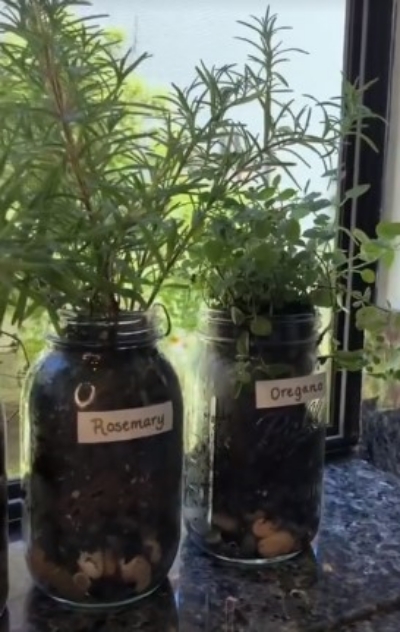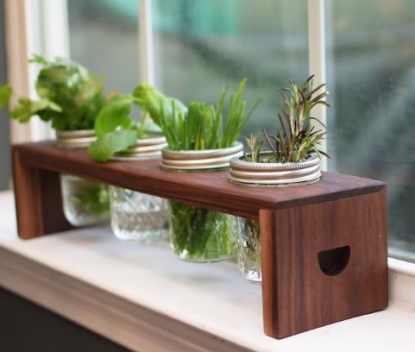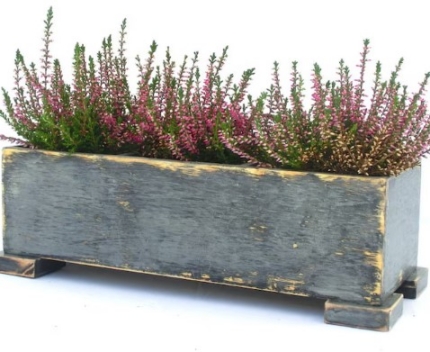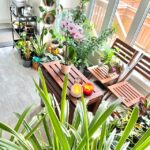This post may contain affiliate links. Please see our full Disclosure Policy for details.
Learn how to create a successful window herb garden in your kitchen, living room or indoor small spaces with herb growing tips, DIY ideas and product recommendations.
Imagine transforming a tiny corner of your home into a lush, miniature garden paradise. For those of you who love the idea of plucking fresh herbs right from your windowsill while you cook, or simply basking in the beauty of indoor greenery, starting a window herb garden is a game-changer. It’s not just about adding a dash of nature to your space; it’s about creating a cozy, vibrant nook that brings life to your kitchen.
In this article, we’re going to unveil a treasure trove to help you kickstart your window herb garden, perfect for any space and suitable for gardeners of all skill levels. Find answers to some of the most common questions to ease any doubts, setting the stage for an exciting journey towards cultivating your very own herb oasis at the end.
Whether you go for a hanging setup, stack your herbs on shelves, or keep it simple with pots on the sill, the perks are endless.
What Herb Plants can be easily grown indoors?
Here are some herbs that can be easily grown indoors:
Basic Herbs for cooking
Basil: This popular herb thrives in warm, sunny locations and moist soil. Pinch back the leaves regularly to encourage bushier growth.
Chives: Chives are a low-maintenance herb that can tolerate a variety of lighting conditions. They grow quickly and you can harvest them frequently.
Mint: Mint is a fast-growing herb that can be invasive. It’s best to grow mint in a pot to prevent it from taking over your garden.
Oregano: Oregano is a perennial herb that can grow indoors for many years. It prefers well-drained soil and full sun.
Parsley: Parsley is a slow-growing herb that prefers cool temperatures and indirect sunlight.
Rosemary: Rosemary is a woody herb that can grow quite large indoors. It needs well-drained soil and at least 6 hours of sunlight per day.
Thyme: Thyme is a versatile herb that can be used in both culinary and medicinal applications. It is a low-growing herb that prefers well-drained soil and full sun.
Cilantro: This fast-growing herb has a pungent flavor and is used in many Mexican and Asian dishes. It prefers cool temperatures and indirect sunlight.
Specialty Herbs for fragrance and tea
Lemon balm: Lemon balm is a lemon-scented herb that can be used in teas, potpourris, and culinary dishes. It prefers well-drained soil and partial shade.
Stevia: Stevia is a natural sweetener that can be grown indoors. It prefers warm temperatures and full sun.
Dill: This annual herb has a delicate flavor and is often used in pickling and fish dishes. It prefers cool temperatures and indirect sunlight.
Sage: Sage is a perennial herb with a slightly peppery flavor. It is used in many Mediterranean dishes. Sage prefers well-drained soil and full sun.
Bay laurel: This slow-growing herb has a strong, bay-like flavor and is used in soups, stews, and marinades. It prefers well-drained soil and partial shade
Catnip: This herb is not only loved by cats, but it can also be used in teas and potpourris. It prefers well-drained soil and full sun.
Chamomile: This calming herb is used in teas and other medicinal applications. It prefers well-drained soil and partial shade.
Lemongrass: This tropical herb has a lemony flavor and is used in many Asian dishes. It prefers warm temperatures and full sun.
Tarragon: This perennial herb has a licorice-like flavor and is used in French cuisine. It prefers well-drained soil and full sun.
Lavender: This fragrant herb is known for its calming properties and can be used in teas, potpourris, and culinary dishes. It prefers well-drained soil and full sun.
Marjoram: This versatile herb has a sweet, oregano-like flavor and is used in many Mediterranean dishes. It prefers well-drained soil and full sun.
Now, let’s get to the ideas of how to place your kitchen garden herbs on windows with some added magical and enchanted touch for your house decor.
DIY Window Herb Garden Ideas
1) DIY Floating Window Plants Shelves are lightweight, easy to clean and safer than glass by Grillo Designs.
Shop Acrylic Sheets for Shelves here
2) DIY Kitchen Windowsill Herb Using a Large Metal Container by Martha Stewart.
3) DIY Inexpensive Herb Garden using modeling paste and plastic bowls by Samantha Potter.
Countertop Herb Garden Ideas
4) Mini Kitchen Countertop Herb Garden makes it a breeze to grab all the fresh seasonings you need for a tasty Italian dinner by HGTV.
5) Three Pot Herb Station on Olive Wood Base from Etsy.
6) Little Herb Kitchen Window Herb Garden for countertops or balcony tops with hammered metal pots by On Sutton Place.
7) DIY Herb Garden Planter by Sara and Melissa.
8) Glazed Ceramic Planter Herb Pot Set with draining dish from Amazon.
Mason Jars Herb Garden
9) Sustainable Window Herb Garden with Mason Jars by Life Wonder’s hub.
10) Floating Herb Garden with masking tape by Sugru.
Tiered Herb Garden Ideas
10) With Five Tier Stackable Herb Planter grow a mix of herbs and greens in one easy-to-assemble planter. It has drainage holes for easy watering and you can rotate for even sunlight from Amazon.
11) Two Tier Hanging Plant Shelf for Kitchen Windows from Etsy.
12) 3-Tier Stackable Vertical Herb Window Garden for a less spacious kitchen from Amazon.
13) Terra cotta vertical herb garden from Craftionary.
Artificial System Indoor Herb Garden
14) LED Lit hydroponics Indoor Herb System for small spaces, this soil-free, LED-lit herb growing system boosts growth by 1.5x. It’s easy to install and yields a garden in 25 days from Amazon.
15) Aero Garden Harvest Elite grows herbs indoors without soil, using LED lights. It supports six herbs, each reaching up to 12 inches from Amazon.
Small Herb Garden Ideas
16) 8-Pocket Raised Herb Planter Bed from Amazon.
You will also like: 60 Affordable Raised Garden Bed Ideas that are easy to setup.
17) Self-Watering Herb Planters from Amazon.
You will also like: 45 Self watering planters DIY ideas and tutorials
Upcycled Herb Garden Ideas
18) Grow Bags Herb Garden offer a breathable, affordable option to pots, featuring easy-to-move handles and are available in biodegradable or non-degradable types. Put them near the windows and relocate whenever needed from Amazon.
19) Amazing Self-Watering Herb Pots from Soda Bottles for Windowsill from Craftionary.
20) DIY Kitchen Herb Garden from Tea Tins by Heart Filled Spaces.
21) Indoor herb garden using tin cans with drainage holes by Sugar and Charm.
22) Vintage Milk Crate Herb Garden by Green Fingers.
Hydroponic Window Herb Garden
23) Mason jar Hydroponic Herb Garden from Craftionary.
24) Clutter-free hydroponic gardening wooden rack with mason jars from Etsy for your windowsill and fresh herbs all year round!
Indoor Herb Garden Planter Box
25) Wooden basket for Indoor Herb Gardening from Etsy.
26) Indoor Herb Garden Kit from Etsy will ease up your gardening task.
27) Keter Easy Grow Herb Garden with elevated garden beds on legs, ideal for herbs and vegetables, come with a water gauge for optimal watering from Amazon.
Hanging Herb Garden Ideas
28) Hook and Hang Mason Jars by Domestically Speaking.
29) Hanging Herb Planters for Window from Amazon.
30) Place Vertical Hanging Herb Window Garden with Shelves on your balcony or kitchen window where sunlight falls directly from Etsy.
What is an herb garden?
An herb garden is your little spot for growing plants that smell amazing and can jazz up your meals, and teas, or even be used in natural home remedies. Start one right on your kitchen windowsill with just a couple of pots or go bigger with a bunch of plants in containers on your deck.
The cool thing about having a herb garden is you always have fresh herbs on hand for cooking, making your teas, or whipping up some natural skincare.
How to start an indoor herb garden?
Starting an indoor herb garden is like creating your little plant paradise inside your home. Here’s how to do it without getting too bogged down in the details:
- Find a Sunny Spot: Look for a place near a window where your herbs can soak up plenty of sunlight. The more, the merrier!
- Choose Your Herbs: Start with herbs that are easy to grow, like basil, mint, parsley, and cilantro. They’re chill and forgiving, even if you’re new to this.
- Get Some Good Pots: Make sure your pots have holes in the bottom so water can drain out. You don’t want your herbs to drown!
- Use the Right Dirt: Grab some potting mix made for indoor plants. It’s light and fluffy, just what your herbs like.
- Planting Time: Follow the instructions on the seed packet or stick your starter plants in the dirt, giving them a bit of space to spread out.
- Watering Wisdom: Give your herbs a drink when the soil feels dry to the touch. Stick your finger in there; if it’s dry an inch down, it’s watering time.
- Feed Them Occasionally: Treat your herbs to some liquid fertilizer now and then, but don’t go overboard. They’re not big fans of fast food every day.
- Snip, Snip: Don’t be shy about using your herbs! Regularly snipping them encourages them to grow nice and bushy. Plus, that’s why you planted them, right? To enjoy them!
And that’s all there is to it! With a bit of sunshine, a little bit of love, and some regular trimming, you’ll have a thriving indoor herb garden adding flavor and freshness to your home in no time.
What type of planters to use for kitchen herb window ideas?
Picking the Perfect Pots
Picking out the perfect pots for your indoor herb garden can feel overwhelming, but trust me, it’s way simpler than it seems! Let’s break it down:
Pot Power:
- Terracotta: These classic, budget-friendly cuties breathe well, keeping your herbs happy, but they tend to dry out faster. Glazed versions hold moisture better, like a built-in water sponge!
- Plastic: Lightweight and easy on the wallet, plastic pots are cleaning champions and retain moisture well. Just make sure they have drainage holes, so your herbs don’t get waterlogged!
- Ceramic: Looking for some style points? Ceramic pots are sturdy and good at draining and keeping things warm for your herbs. They can be a bit pricier, but hey, you got to treat yourself sometimes, right?
- Wood: Eco-friendly and undeniably charming, wooden planters add a rustic touch to your kitchen jungle. Just make sure they’re treated to handle moisture and have drainage holes to avoid unhappy herbs.
- Metal: Modern and sleek, metal planters can be light or heavy depending on the type. Opt for coated or painted ones to avoid rust, and don’t forget drainage holes!
Size It Up:
- Match the pot size to your herb’s needs. Bigger herbs like rosemary and basil need more space (think 6-8 inches), while smaller ones like thyme and parsley are happy in 4-inch pots.
- Space matters! Choose pots that fit comfortably on your windowsill, countertop, or wherever your herb garden will call home.
- Think visually. Planters of similar sizes and styles create a neat and pleasing look, making your herb haven truly Instagram-worthy.
Drainage Drama? No Problem!
- Drainage holes are essential! Look for pots with them to prevent your herbs from drowning in their little puddles.
- No drainage holes. No worries! Place the pot on a saucer or tray to catch excess water. Just remember to empty it regularly so your herbs don’t get grumpy.
Bonus Features (optional, but fun!):
- Self-watering planters: These pots have a built-in water reservoir, perfect for forgetful plant parents (we’ve all been there!).
- Hanging planters: Save space and add a vertical touch with hanging planters. Great for creating a lush, cascading herb garden.
- Herb garden kits: Often come with pots, seeds, and sometimes even soil, making it a super convenient option for beginners.
Remember, choose planters that reflect your style and complement your kitchen vibes!
Easy-to-use herb garden kits for beginners
Here are some easy-to-use and beginner-friendly herb garden kits for you
Why is growing herbs so hard?
Think of herbs as your picky friends who want everything just right: the perfect amount of sunlight, the right amount of water, and a comfy spot with the right kind of soil. They all have their likes and dislikes, making it a bit of a game to keep them all happy.
What Herbs are hardest to grow?
Coriander is a bit of a drama queen, bolting (or flowering) the moment it gets too warm, while French tarragon is super picky and needs everything just so to flourish.
What herbs are easy to grow?
Basil, mint, and chives are super chill and won’t give you a hard time. They’re flexible and can thrive with just some basic care, making them awesome buddies for beginner gardeners.
Which herbs like to be crowded?
Mint loves a party and doesn’t mind being packed in close with other plants. Just a heads-up, though: it loves to spread out and can take over if you’re not careful.
How to grow herbs in my window?
Creating a mini garden on your windowsill is easier than you think. Find a sunny spot, grab some pots with drainage holes to keep hydroponic getting too wet, and fill them up with some Herbs plowing soil. Plant your herbs, keep the soil lightly moist, and give a heart-filled little spin now and then to make sure everyone gets their turn in the sun. It’s like having your little green oasis without stepping outside!
How long do potted herbs last?
Potted herbs are kind of like that long-lasting lip balm – with the right care, they can stick around for a good while. If you treat them right, many herbs can keep you company for months or even years. It’s all about giving them what they need to thrive.
Do herbs need full sun or shade, and how much sun do they need?
Herbs love catching some rays but aren’t all about that all-day suntan. Most of them are happy with about 4-6 hours of sunlight a day. Think of them as enjoying a nice day at the beach but with some time spent under the umbrella too.
How often should I water my window herb garden?
Watering your window herb garden is like feeding a cat – it’s a delicate balance. Too much, and you’ll drown them; too little, and they’ll start giving you the silent treatment. A good rule of thumb is to water them when the top inch of soil feels dry. Stick your finger in the soil; if it feels dry, it’s time for a drink.
Should I spray my potted herbs with water?
Misting your potted herbs can be like giving them a mini spa day. It’s not always necessary, but in drier climates or during the winter when indoor heating can dry out the air, a gentle misting can help keep them happy. Just don’t overdo it – nobody likes to be soggy.
How do you keep supermarket potted herbs alive?
Supermarket potted herbs are a bit like rescue plants – they need a little extra love, tenderness, and care to thrive. First, give them a bigger home (a larger pot) and some fresh soil to spread their roots. Keep them in a sunny spot, water them just right, and trim them regularly to encourage growth. It’s like rehab for plants, giving them a second shot at life.
Are coffee grounds good for herbs?
Coffee grounds are like vitamins for some herbs, adding a bit of a boost to the soil. They can help improve soil drainage, water retention, and aeration. Plus, they add a bit of acidity, which some herbs love. Just use them sparingly – a little goes a long way.
Do indoor potted herbs come back every year?
Indoor potted herbs can be the gift that keeps on giving, but it depends on the herb. Perennials like rosemary, thyme, and mint can come back year after year, giving you endless seasoning for your cooking. Annuals, on the other hand, live their best life in one season. Treat herbs right, and perennials will be your loyal kitchen companions for a long time.
A window herb garden isn’t just about adding a splash of green to your space; it’s like having a mini farm at your fingertips. Picture this: plucking fresh basil or mint straight from your window and tossing it into your favorite dishes—it’s an instant upgrade to your meals.
Written by: Sabah Waqas
















































